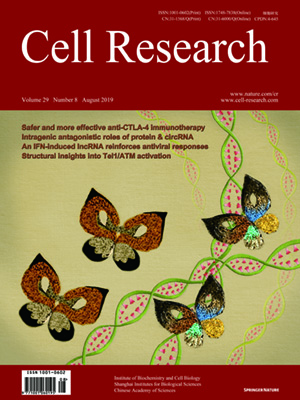
Volume 29, No 8, Aug 2019
ISSN: 1001-0602
EISSN: 1748-7838 2018
impact factor 17.848*
(Clarivate Analytics, 2019)
Volume 29 Issue 8, August 2019: 609-627 | Open Access
ORIGINAL ARTICLES
Hijacking antibody-induced CTLA-4 lysosomal degradation for safer and more effective cancer immunotherapy
Yan Zhang1, Xuexiang Du1, Mingyue Liu1, Fei Tang1, Peng Zhang1, Chunxia Ai1, James K. Fields 2,3 , Eric J. Sundberg 2,4,Olga S. Latinovic 2,4, Martin Devenport5 , Pan Zheng 1,5,6 and Yang Liu 1,5,6
1Divisions of Immunotherapy, University of Maryland Baltimore School of Medicine, Baltimore, MD 21201, USA; 2 Divisions of Basic Science Division, Institute of Human Virology, University of Maryland Baltimore School of Medicine, Baltimore, MD 21201, USA; 3Graduate Program in Molecular Microbiology and Immunology, University of Maryland Baltimore School of Medicine, Baltimore, MD 21201, USA; 4Department of Microbiology and Immunology, University of Maryland Baltimore School of Medicine, Baltimore, MD 21201, USA; 5OncoImmune, Inc, Rockville, MD 20850, USA and 6Department of Surgery, University of Maryland Baltimore School of Medicine, Baltimore, MD 21201, USA
Correspondence: Yan Zhang (yzhang@ihv.umaryland.edu) or Pan Zheng (pzheng@ihv.umaryland.edu) or Yang Liu (yaliu@ihv.umaryland.edu)These authors contributed equally: Yan Zhang, Xuexiang Du, Mingyue Liu
It remains unclear why the clinically used anti-CTLA-4 antibodies, popularly called checkpoint inhibitors, have severe immunotherapy-related adverse effects (irAEs) and yet suboptimal cancer immunotherapeutic effects (CITE). Here we report that while irAE-prone Ipilimumab and TremeIgG1 rapidly direct cell surface CTLA-4 for lysosomal degradation, the non-irAE-prone antibodies we generated, HL12 or HL32, dissociate from CTLA-4 after endocytosis and allow CTLA-4 recycling to cell surface by the LRBA-dependent mechanism. Disrupting CTLA-4 recycling results in robust CTLA-4 downregulation by all anti-CTLA-4 antibodies and confers toxicity to a non-irAE-prone anti-CTLA-4 mAb. Conversely, increasing the pH sensitivity of TremeIgG1 by introducing designed tyrosine-to-histidine mutations prevents antibody-triggered lysosomal CTLA-4 downregulation and dramatically attenuates irAE. Surprisingly, by avoiding CTLA-4 downregulation and due to their increased bioavailability, pH-sensitive anti-CTLA-4 antibodies are more effective in intratumor regulatory T-cell depletion and rejection of large established tumors. Our data establish a new paradigm for cancer research that allows for abrogating irAE while increasing CITE of anti-CTLA-4 antibodies.
https://doi.org/10.1038/s41422-019-0184-1
FULL TEXT | PDF
Browse 1279


